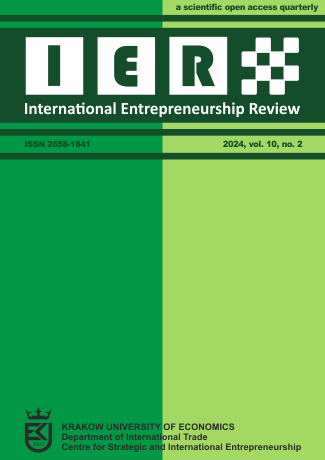In search of a benchmark for the quick ratio: The Polish-German setting

Abstract
Objective: The objective of the article is to empirically assess the benchmarks for the quick ratio (QR) commonly provided in the Polish literature. The article challenges the suggestion of a single benchmark despite a country’s and industry’s uniqueness. It concentrates on the Polish-German setting because of the intensive cooperation between the two countries.
Research Design & Methods: Apart from reviewing and critiquing the existing literature, the article presents the results of empirical analysis. The research sample comprised 998 710 Polish firm-years and 1 579 619 German ones. Data was retrieved from the Orbis Database for going concern, non-financial firms from 2013 to 2022. Research methods comprised analyses of distributions, including descriptive statistics and histograms, parametric and nonparametric ANOVA, and trend analysis.
Findings: The analysis shows that the benchmark for the quick ratio depends on the country, industry, period, and firm size. Standards should be drawn from quartiles instead of the arithmetic mean because of the high variability of QR. The range for QR is respectively wide. For Poland, it ranges from 0.6 (the first quartile) to 2.7 (the third quartile), with a median of 1.2 for the total sample. For Germany, it ranges from 0.7 (the first quartile) to 3.9 (the third quartile), with a median of 1.6. Benchmarks vary annually in Poland and Germany. Medians and third quartiles increase over time. They grow faster in Germany. There are substantial between-industry differences in both countries. The pattern of these differences is unique to a country. The size of the firm negatively influences the desired liquidity level in both countries.
Implications & Recommendations: Because of substantive between-country, industry, period, and firm size differences in benchmarks, analysts and investors must be sensitive to the standards they use in assessing investment opportunities. A shock in the economy increases risk and, hence, benchmarks.
Contribution & Value Added: The article’s main contribution is the empirical verification of benchmarks for the quick ratio provided in the Polish literature. Analysts should not trust theoretical concepts when looking for benchmarks. They must compare the firm’s financial standing with that of other firms from the same country, industry, period, and of a similar size.
Keywords
liquidity ratios, quick ratio, financial analysis, Poland, Germany
Author Biography
Piotr Wójtowicz
PhD, Associate Professor at the Krakow University of Economics (Poland). His research interests include financial reporting, earnings management, and the impact of cultural factors on earnings quality.
References
- Bereżnicka, J. (2014). Financial Liquidity and Profitability of Family Farms – Interdependence Dilemma. Prace Naukowe Uniwersytetu Ekonomicznego we Wrocławiu, 325 Management of Enterprises’ Finance – Theory and Practice, 9-18.
- Comporek, M. (2023). Accrual-based earnings management and organizational life cycles: Two-dimensional analysis. International Entrepreneurship Review, 9(1), 97-108. https://doi.org/10.15678/IER.2023.0901.07
- Dudycz, T., & Skoczylas, W. (2023). Wskaźniki finansowe przedsiębiorstw według działów (sektorów) za 2021 r. Rachunkowość, (5), 61-88. Retrieved from https://rachunkowosc.com.pl/files/Rachunkowosc-sektorowe-wskazniki-finansowe-2021.pdf. on July 1, 2023.
- European Commission. (2023). SME Definition. European Commission. Retrieved from https://single-market-economy.ec.europa.eu/smes/sme-definition_en on September 22, 2023.
- Eurostat. (2023). NACE Rev. 2. Statistical classification of economic activities in the European Community. Retrieved from https://ec.europa.eu/eurostat/documents/3859598/5902521/KS-RA-07-015-EN.PDF on September 29, 2023.
- Hońko, S., Strojek-Filus, M., & Świetla, K. (2023). Regulation or deregulation of the accounting profession in a sustainable economy? Evidence from Poland. International Entrepreneurship Review, 9(3), 91-107. https://doi.org/10.15678/IER.2023.0903.06
- Kanagaretnam, K., Lim, C.Y., & Lobo, G.J. (2011). Effects of national culture on earnings quality of banks. Journal of International Business Studies, 42, 853-874. https://doi.org/10.1057/jibs.2011.26
- Kreczmańska-Gigol, K. (Ed.) (2020). Analiza płynności finansowej przedsiębiorstwa. Płynność strukturalna. Płynność potencjalna. Zdolność płatnicza. Difin S.A.
- Lesiak, M., & Sajnóg, A. (2018). The Strategies of Net Working Capital Management and Their Impact on the Profitability of Polish IT and Electromechanical Stock Companies. Studia Prawno-Ekonomiczne, 109, 241-256. https://doi.org/10.26485/SPE/2018/109/15
- Lev, B. (1969). Industry Averages as Targets for Financial Ratios. Journal of Accounting Research, 7(2), 290-299. https://doi.org/10.2307/2489971
- Lisek, S., Luty, L., & Zioło, M. (2019). The Financial Situation of Food Sector Public Companies. Annals of the Polish Association of Agricultural and Agribusiness Economists, 21(4), 267-277. https://doi.org/10.5604/01.3001.0013.5571
- Maślach, D., Markiewicz, J., Warelis, A., & Krzyżak, M. (2019). Importance of Financial Liquidity in Hospital Management. Epidemiological Review / Przegląd Epidemiologiczny, 73(3), 369-381. https://doi.org/10.32394/pe.73.30
- Michalski, G. (2005). Płynność finansowa w małych i średnich przedsiębiorstwach. Wydawnictwo Naukowe PWN.
- Niemiec, A. (2014). Wielkości graniczne statycznych wskaźników płynności finansowej. Zeszyty Teoretyczne Rachunkowości (The Theoretical Journal of Accounting), 79(135), 57−69.
- OEC. (2023). Poland-Germany Comparison. OEC. Retrieved from https://oec.world/en/profile/bilateral-country/deu/partner/pol on September 27, 2023.
- Pichler, J.H. (2018). In Quest of SME-Conducive Policy Formulation. Entrepreneurial Business and Economics Review, 6(1), 105-113. https://doi.org/10.15678/EBER.2018.060106
- Sestanj-Peric, T., Keglevic Kozjak, S., & Kovsca, V. (2019). Financial ratios benchmarks average of industry or some other measure? Retrieved from (pdf) Financial ratios benchmarks - average of industry or some other measure? (researchgate.net) on December 17, 2023.
- Sierpińska, M., & Jachna, T. (2004). Ocena przedsiębiorstwa według standardów światowych. Wydawnictwo Naukowe PWN.
- Szymańska, E., & Lukoszová, X. (2021). Liquidity and Profitability of Meat Processing Enterprises in Poland. Zagadnienia Ekonomiki Rolnej / Problems of Agricultural Economics, 4, 135-153.
- Tóth, M., Čierna, Z., & Serenčéš, P. (2013). Benchmark values for liquidity ratios in Slovak agriculture. Acta Scientiarum Polonorum. Oeconomia, 12(3), 83-90. Retrieved from https://js.wne.sggw.pl/index.php/aspe/article/view/4090 on September 2, 2023.
- Trading Economics. (2023). Poland Exports to Germany. Trading Economics. Retrieved from https://tradingeconomics.com/poland/exports/germany on September 25, 2023.
- Wójtowicz, P. (2022). Questing benchmarks for the current ratio: An analysis of the Warsaw Stock Exchange firms. International Entrepreneurship Review, 8(4), 83-97. https://doi.org/10.15678/IER.2022.0804.06
